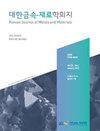Solid-State Synthesis and Thermoelectric Performance of Cu3Sb1−yBIII ySe4 (BIII = Al, In) Permingeatites
IF 1.4
4区 材料科学
Q4 MATERIALS SCIENCE, MULTIDISCIPLINARY
引用次数: 1
Abstract
Permingeatite (Cu3SbSe4) is a promising thermoelectric material with narrow bandgap energy and large carrier effective mass. However, doping is required to improve its electrical conductivity and thermoelectric properties. In this study, Cu3Sb1−y(Al/In)ySe4 doped with BIII-group elements (Al or In) at the Sb sites was synthesized using mechanical alloying followed by sintering through hot pressing. The resulting Cu3Sb1−y(Al/In)ySe4 contained a single phase of permingeatite with a tetragonal structure and therefore achieved a high relative density of 97.5–99.2%. The substitution of Al/In at the Sb sites produced lattice constants of a = 0.5652–0.5654 nm and c = 1.1249–1.1254 nm. As the Al/In doping content increased, the carrier (hole) concentration increased, reducing the Seebeck coefficient and increasing the electrical and thermal conductivities. Substituting Al3+ or In3+ at the Sb5+ site can generate additional carriers, resulting in a high electrical conductivity of (1.4–1.1) × 104 Sm−1 at 323–623 K for Cu3Sb0.92In0.08Se4. Cu3Sb0.96Al0.04Se4 exhibited a maximum power factor of 0.51 mWm−1K−2 at 623 K and a minimum thermal conductivity of 0.74 Wm−1K−1, resulting in a maximum dimensionless figure of merit, ZT, of 0.42 at 623 K. Cu3Sb0.96In0.04Se4 obtains a ZT of 0.47 at 623 K, indicating a high power factor of 0.65 mWm−1K−2 at 623 K and low thermal conductivity of 0.84 Wm−1K−1 at 523 K.Cu3Sb1−yBII ySe4(BIII=Al,In)介电质的固态合成及其热电性能
辉长石(Cu3SbSe4)是一种具有窄带隙能和大载流子有效质量的热电材料。然而,需要掺杂来改善其导电性和热电性能。本研究采用机械合金化后热压烧结的方法合成了在Sb位点掺杂biii族元素(Al或In)的Cu3Sb1−y(Al/In)ySe4。得到的Cu3Sb1−y(Al/In)ySe4含有单相四方结构的透辉岩,因此相对密度高达97.5-99.2%。Al/In在Sb位点的取代产生的晶格常数分别为a = 0.5652 ~ 0.5654 nm和c = 1.1249 ~ 1.1254 nm。随着Al/In掺杂量的增加,载流子(空穴)浓度增加,塞贝克系数降低,电导率和导热系数增加。在Sb5+位置取代Al3+或In3+可以产生额外的载流子,从而使Cu3Sb0.92In0.08Se4在323-623 K下的电导率达到(1.4-1.1)× 104 Sm−1。Cu3Sb0.96Al0.04Se4在623 K时的最大功率因数为0.51 mWm−1K−2,最小导热系数为0.74 Wm−1K−1,从而在623 K时的最大无因次优值ZT为0.42。Cu3Sb0.96In0.04Se4在623 K时的ZT为0.47,表明其在623 K时的功率因数为0.65 mWm−1K−2,导热系数为0.84 Wm−1K−1。
本文章由计算机程序翻译,如有差异,请以英文原文为准。
求助全文
约1分钟内获得全文
求助全文
来源期刊

Korean Journal of Metals and Materials
MATERIALS SCIENCE, MULTIDISCIPLINARY-METALLURGY & METALLURGICAL ENGINEERING
CiteScore
1.80
自引率
58.30%
发文量
100
审稿时长
4-8 weeks
期刊介绍:
The Korean Journal of Metals and Materials is a representative Korean-language journal of the Korean Institute of Metals and Materials (KIM); it publishes domestic and foreign academic papers related to metals and materials, in abroad range of fields from metals and materials to nano-materials, biomaterials, functional materials, energy materials, and new materials, and its official ISO designation is Korean J. Met. Mater.
 求助内容:
求助内容: 应助结果提醒方式:
应助结果提醒方式:


